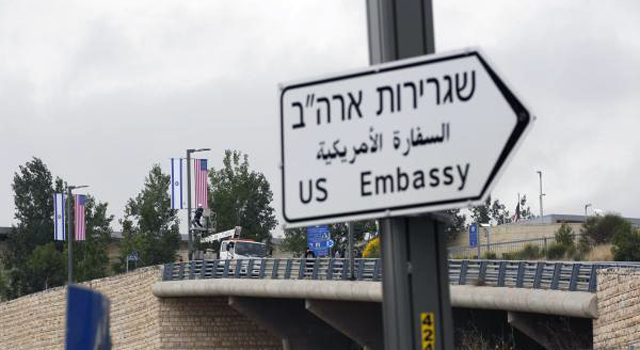
By The Ledger Editorial Advisory Board
May 2018 will be remembered for two monumental shifts in American foreign policy towards the Middle East, as the United States withdrew from the Iran deal, and the United States formally opened its embassy in Jerusalem, the capital of the state of Israel.
Withdrawing from the Joint Comprehensive Plan of Action (JCPOA) will take between 60-90 days to come into effect, as the United States gradually and unilaterally reimposes crippling economic sanctions on Tehran. The revamped national security team of the Trump administration (now on its second Secretary of State and third National Security Advisor in 16 months) promises that American withdrawal from the JCPOA will lead to an ultimately better deal and a safer region. Critics of the JCPOA withdrawal – even amongst those who initially opposed the Iran Deal when it was first imposed by President Obama – are convinced that the abandonment of the Iran nuclear deal will lead to a far more dangerous international order.
Moving the U.S. embassy to Jerusalem was announced back in December of last year. It will take years and several 100 million dollars to actually build a full-working embassy in the City of David, but President Trump, his Ambassador to Israel David Friedman, and Israeli Prime Minister Netanyahu had a different idea.
Just do it. Take a consular annex in West Jerusalem and rearrange the small office suite and put up a few street signs and a plaque on the wall. Do it on the 70th anniversary of US recognition of Israel by President Truman. Do it on Jerusalem Day. Do it on May 14.
Like everything else associated with the embassy move, the rush to open was fumbled. The timing, so full of meaning for Israel, turned out to be photogenically disastrous, as annual Nakba Day commemorations, which this year coincided with the Hamas-orchestrated March of Return, culminated in a murderous scene of confrontation on the Gazan border.
There was nothing earth-shaking about the Gaza confrontation. Ever since the Palestinians formally adopted Nakba Day as a “thing” back in 1998, there have been deadly face-offs between Israeli security and Palestinian protestors. Before this year’s weekly protests crescendoed on May 14 (to coincide precisely with the Jerusalem embassy opening) there have been other deadly border confrontations. In 2011, Palestinian and Syrian activists assaulted the Israeli border on the Golan Heights. A dozen marchers were killed by Israeli forces, and a few dozen marchers actually penetrated into Israeli territory, where they were rounded up and ultimately deported.
The Nakba (“catastrophe” in Arabic) marks the Gregorian date of the establishment of Israel back in 1948. It supposedly marks in Palestinian national memory the day that the travesty of Israel came to fruition. But while today the Nakba is a collective marker for the “catastrophe” of Israel’s existence, the word was first used by Arab writers to mark the 1948 calumny of Arab abandonment of the Palestinian national cause. Like many symbols of the Israeli-Palestinian blood feud, the Nakba has meant different things at different times.
For viewers with no memory, the confrontation at the Gaza border seemed historic. For a news cycle, supporters of Palestine wailed about the disproportionate use of deadly force by the Israeli military against (largely) unarmed marchers. Israel maintained that under the rules of international law the response to a massive assault on its border by marchers complicit with Hamas’ war of terror was fully justified. Critics of Israel called it a humanitarian travesty.
It all was recycled arguments, soon to be lost to the chaos of the next Trump news cycle.
So while the carnage at the Gaza border was broadcast split-screen with the embassy celebration, and provided a sour counterpoint to the tr(i)umphant unveiling of a chiseled plaque on a converted consulate annex, there was nothing historic or remarkable about the seemingly ironic images broadcast that day around the world.
What was historic and remarkable on May 14 was the celebratory love fest held between the Trump and Netanyahu administrations in Jerusalem. It marked the (un)holy alliance between a certain style of Orthodox Jewish Zionism and Christian Zionism, which has become the hallmark of both leaders. It was at the specific invitation of David Friedman, President Trump’s emissary to Jerusalem, that the messianically-charged and Trump apologists/preachers Robert Jeffress and John Hagee, both of whom have engaged in theological antisemitism, opened and closed the ceremonies.
As a coda, the Jerusalem football club Beitar Yerushalayim formally changed its name to honor the new national hero of the state of the Jews. While worldwide Trump-branded properties are working to have the name TRUMP removed, footballers in Jerusalem will now be supporting Beitar Trump Yerushalayim.
Most American Jews, still firmly in the Never Trump camp, could only scratch their heads in wonderment tinged with sadness.
This historic realignment of U.S. foreign policy with the muscular and unapologetic messianism of Orthodox Judaism and evangelical Protestantism – also to be found in tearing up the JCPOA – will be the truly historic transformation that May 2018 portends.








 Southern New England Jewish Ledger
Southern New England Jewish Ledger








